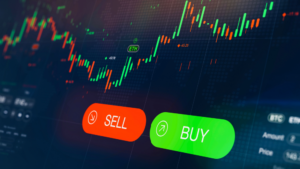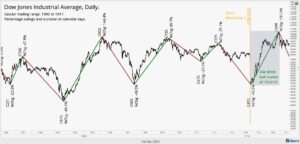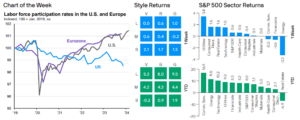Wednesday, 24th November, 2021
1/ Historic market moves
2/ Black Friday is a winning day
3/ Trading after Black Friday
4/ The bottom line
1/ Historic Market Moves
Doing your Christmas shopping on the day after Thanksgiving Day is a time-honored tradition in the U.S. However, it wasn’t until 1966 that someone used the term “Black Friday” to describe the event. In a way that makes sense because 1965 may have been the first time a “must-have” toy appeared for sale just in time for holiday shoppers. That year there were a lot of kids to go shopping for. After all, a sizeable chunk of children born during the last three years of the baby-boom, 1960-1963, were then into their toy-craving years.
The market was ripe for Hasbro (HAS) to release their blockbuster new toy, G.I. Joe, as a way to keep up with rival Mattel’s (MAT) wildly successful Barbie dolls. G.I. Joe would soon account for more than half of Hasbro’s revenue over the next two years, so the uptick in shopping was no joke. With these events in mind, it seems like 1965 would be a good year to start tracking the results of the stock market’s performance on and following Black Friday.
The stock market’s performance on that given day each year has never been thought to be particularly noteworthy. The major exchanges, after all, are typically operated on an abbreviated session schedule. But perhaps the undersized hours shouldn’t overshow the outsized influence the day seems to have. When you consider that the only people who trade that day must really want to, it makes you wonder whether that particular group of participants has any kind of bias to their trading. What follows here is an attempt to determine whether the day’s performance each year since 1965 holds any information that differs in comparison to everyday trading results.
2/ Black Friday is a Winning Day
The first observation that jumps out from reviewing the charts of the S&P 500 Index (SPX) is the frequency with which the day tends to close higher compared to the previous session’s close on the Wednesday before Thanksgiving. This occurs about 70% of the time. For comparison, State Street’s S&P 500 index-tracking ETF (SPY) has closed higher 53% of all days throughout the last 27 years since its inception.


Though this day does tend to close higher more often than random results might suggest, another observation is that the relative change of the index may be an indicator of how the rest of that particular year will turn out. If the market closes in positive territory, but only mildly so, then this indication has historically not boded well for the remainder of the year’s performance.
The figure below specifies the return of the S&P 500 from Black Friday through the end of December for each year where the index closed positive but with less than .3% gain. The average return for the final weeks of those years is a -.28% loss. That’s not particularly inviting. However, when the day closes higher or lower than this range, the results become more interesting.


3/ Trading After Black Friday
Tracking the results that could come from making an SPY trade after Black Friday is an interesting possibility. For tracking purposes, the following data assumes buying the index at the open on the following Monday and closing the trade at the market close price on the subsequent Dec. 31st.
It turns out that if Black Friday closes more than .3% higher compared to the previous Wednesday’s close, the returns for the remainder of the year have been a good bit more desirable. The figure below gives the detail. The average return of the final weeks of these years is over 1.5% (more than double the average monthly gain for the index).
However, a more surprising result occurs when the markets close lower for the day. In those years the market gains even more ground in its closing weeks (the detail is shown in the second figure below). The average return for years where Black Friday trades down from the previous day is nearly 2.5%.
Last year’s results were an interesting study in this regard. Black Friday 2019 closed -.37% lower, just enough to be considered a negative day instead of a neutral one. The resulting performance through the end of the year was fairly strong (2.33%). An interesting note was that the performance for last year was similar to two other periods where the market was recovering from a steep drop the year before (’03 and ’09). The next most similar year was the follow-on from the infamous 1987 crash. The pandemic last year created both a tremendous drawdown and a dramatic recovery. 2018 was one of the worst years on record for end-of-year performance, it stands to reason that 2019 should have behaved like a recovery year also.
2020 was a neutral year, even though the market had made a strong recovery from earlier that year based on the pandemic. As it turned out, its performance marked the best performance on record after a neutral day.
A cautionary note is that though most of these years trade positively, the down years are the worst of any recorded since 1965. So, making this kind of trade is by no means without risk.




4/ The Bottom Line
Black Friday traders do experience more days that close higher than typical market days. Those who use Black Friday as an indicator find that the day’s performance implies good returns from the market through the remainder of the year if that day is decisively positive or negative.
—
Originally posted on 24thNovember, 2021
Disclosure: Investopedia
Investopedia.com: The comments, opinions and analyses expressed herein are for informational purposes only and should not be considered individual investment advice or recommendations to invest in any security or to adopt any investment strategy. While we believe the information provided herein is reliable, we do not warrant its accuracy or completeness. The views and strategies described on our content may not be suitable for all investors. Because market and economic conditions are subject to rapid change, all comments, opinions and analyses contained within our content are rendered as of the date of the posting and may change without notice. The material is not intended as a complete analysis of every material fact regarding any country, region, market, industry, investment or strategy. This information is intended for US residents only.
Disclosure: Interactive Brokers
Information posted on IBKR Campus that is provided by third-parties does NOT constitute a recommendation that you should contract for the services of that third party. Third-party participants who contribute to IBKR Campus are independent of Interactive Brokers and Interactive Brokers does not make any representations or warranties concerning the services offered, their past or future performance, or the accuracy of the information provided by the third party. Past performance is no guarantee of future results.
This material is from Investopedia and is being posted with its permission. The views expressed in this material are solely those of the author and/or Investopedia and Interactive Brokers is not endorsing or recommending any investment or trading discussed in the material. This material is not and should not be construed as an offer to buy or sell any security. It should not be construed as research or investment advice or a recommendation to buy, sell or hold any security or commodity. This material does not and is not intended to take into account the particular financial conditions, investment objectives or requirements of individual customers. Before acting on this material, you should consider whether it is suitable for your particular circumstances and, as necessary, seek professional advice.






























